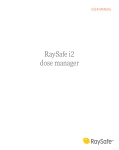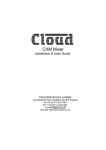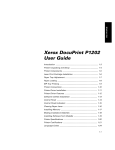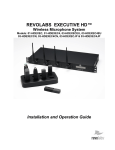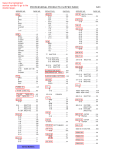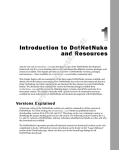Download About Desktop Doctor 2.0
Transcript
Desktop Doctor 2.0 Ergonomic Software User’s Manual For the Consultant Table of Contents Page About Desktop Doctor 2.0 1 Installation of Desktop Doctor 2.0 2 About R.U.L.A. 3 Neutral Postures/Workstation Design 4 Therapeutic Exercises 4 Monitor Your Progress 5 How does Desktop Doctor 2.0 compliment health & safety? 6 OSHA’s general duty clause 7 Who should you approach about Desktop Doctor 2.0? 7-8 The benefits of Desktop Doctor 2.0. 8-9 The Importance of Desktop Doctor 2.0 10 Who is Managing Safety? 11 What are the behaviors of the safety professional? 11 Marketing Strategy 12 How do I get remuneration? 12 Tools Needed 13 Consultation Services 13-20 I. Introductory Meeting II. Behavior III. Training sessions for each employee with Desktop Doctor IV. Remedial Training V. Quarterly Refresher Report of Findings 19 Workstation Assessment Survey 21 Limitation of Liability 22 Supporting Documents 23-25 Page 1 About Desktop Doctor 2.0 Computer Wellness, Inc. has developed Desktop Doctor 2.0 ergonomic software to improve performance and enhance the comfort, health, and safety of the computer user. Desktop Doctor 2.0 combines: Rapid Upper Limb Assessment (R.U.L.A.), neutral postures information, therapeutic exercises, video library, and outcome assessment tools (to benchmark & monitor). This paradigm is based on the health care model: assessment, treatment and education, and outcome assessment. Our goal is to help the computer user, compliment the health & safety team, and provide a valuable tool to the doctor. We know that the best way to provide safety training is on an ongoing basis. Desktop Doctor 2.0 is available to the computer user “on-demand”. This training tool is far superior to the occasional training, which we know provides short-lived results. The cost per man-hour is a great value! Page 2 Installation of Desktop Doctor 2.0 The software insert booklet has the installation instructions. Windows: Windows 3.1 requires the 16-bit version of Desktop Doctor. Execute the SETUP16.EXE application, which is located inside the SETUP16 folder. Windows 95/NT requires the 32-bit version of Desktop Doctor. Execute the SETUP32.EXE application, which is located inside the SETUP32 folder. This will take you through the setup procedure, and create the program group icon for the program manager. Make sure you have QuickTime 2.1 or later installed. QuickTime 2.1 is included on the Desktop Doctor 2.0 CD-ROM. Macintosh: Insert the CD-ROM, and launch the installer. This will take you through the setup procedure. *The registration number is located on the label adhered to the CD shrink-wrap packaging. If you loose the label containing the registration number please call 800-706-8617 or email Dr. McCarthy at: [email protected]. The registration card contained on the inside of the CD jewel case should be returned to be eligible for customer support. Page 3 Desktop Doctor 2.0 ergonomic software utilizes the medical paradigm of assessment, treatment and outcomes assessment. R.U.L.A. is the assessment tool. About R.U.L.A. McAtamney, L., Corlett N. RULA: A Survey Method for the investigation of work-related upper limb disorders. Applied Ergonomics. 1993, 24(2), 91-99. R.U.L.A. (rapid upper limb assessment) is a survey method developed for use in ergonomics investigations of workplaces where work-related upper limb disorders are reported. This tool requires no special equipment in providing a quick assessment of the postures of the neck, trunk and upper limbs along with muscle function and the external loads experienced by the body. A coding system is used to generate an action list, which indicates the level of intervention required to reduce the risks of injury due to physical loading on the operator. It is of particular assistance in fulfilling the assessment requirements of both the European Community Directive (90/270/EEC) on the minimum safety and health requirements for work with display screen equipment and the UK Guidelines on the prevention of work-related upper limb disorders. Page 4 Desktop Doctor 2.0 includes workstation design & therapeutic exercise treatment for the computer user. Neutral Postures/Workstation Design Does your workstation fit? To find out, go to the INFORMATION section of Desktop Doctor and learn how you can take better care of your eyes, arms, back and legs while you are at your workstation. Therapeutic Exercises Lee, K., N. Swanson, S. Sauter, R. Wickstrom, A. Walker, M.Mangum. A review of physical exercises recommended for the VDT operators. Applied Ergonomics. 1992,23(6) 387-408. Desktop Doctor 2.0 exercises are therapeutic and are easy to perform at the workstation. The models are in office attire giving the impression that working out at the office is acceptable and easy. Just follow the movements of the models in the film clip, as you would do a Tae Bo workout. Each exercise film clip is real time and is supported by voice instruction and a text help screen. The INFORMATION screen includes instruction for static stretching derived from the ACSM’s Guidelines For Exercise Testing and Prescription 5 th Edition. Page 5 Monitor Your Progress Desktop Doctor 2.0 has two outcome assessment tools. One for the neck called the Neck Disability Index and one for the arms, wrists and hands, called the Symptom Severity Scale. Take the test! The scoring is automatic and will be archived and dated for comparison. We recommend that you take the test once a month if you have no discomfort. Take the test every two weeks if you have discomfort. Page 6 How does Desktop Doctor 2.0 compliment health & safety? “Work-Related Musculoskeletal Disorders (WMSD’s) account for 34% of all lost workday injuries and illnesses. In 1996, there were 647,000 lost days attributed to WMSDs. OSHA has found WMSDs to account for more than $15-20 Billion dollars in workmen’s’ compensation costs. Leading the list were carpal tunnel syndrome cases, which averaged more days away from work (25) than any other workplace injury. “ Bautch and Conway “Two recent studies of insurance claims show that the current cost of cumulative trauma disorders, such as repetitive motion injuries and low back pain, is more that $11.5 billion annually. Other injuries include postural and spinal stress and tendonitis. Carpal tunnel syndrome alone affects approximately 230,000 people every year and accounts for nearly half of all workplace illnesses, costing the country nearly $800 million in benefits and rehabilitation.” Desktop Doctor 2.0 is an adjunct for the ergonomist in the control of repetitive stress illness. The software is continuous training for the computer user providing “on-demand” information about assessment of the workstation, workstation design, signs & symptoms, and therapeutic exercises to prevent musculoskeletal problems. Desktop Doctor 2.0 is another resource for the computer user who may be waiting for an appointment with the ergonomist. We have found that the ergonomist/health & safety team appreciates this valuable tool. Page 7 OSHA’s general duty clause Section 5. Duties Section Number: 5 Section Title: Duties (a) Each employer (1) shall furnish to each of his employees employment and a place of employment which are free from recognized hazards that are causing or are likely to cause death or serious physical harm to his employees. (1997) Who should you approach about Desktop Doctor 2.0? Risk managers and human resource personnel are looking for ways to help their customers/employees in new and innovative ways. A percentage of the premium for worker compensation is applied to training and products for the insurer’s client. Desktop Doctor 2.0 is a tool for training and a product for sale. Sixty-four percent of job-related illnesses in 1996 were associated with repeated trauma (carpal tunnel, noise-induced hearing loss and bursitis). Since 1986, the incidence of job-related illness has doubled. Another market is your patient’s. In the first quarter of 1998, 21 million computers were sold in the U.S. Children are coming down with “Nintendo thumb”. Computer use starts at preschool and becomes more intense at middle school age. The students begin writing papers, email their friends and play games for hours. Ergonomic furniture is not the answer; children Page 8 will grow out of the desk in the same time they will grow out of their shoes. The public needs our information and services to develop good habits. The Benefits of Desktop Doctor 2.0 Low initial cost…suggested retail of $99.00/license. When you consider the cost per “man-hour”, Desktop Doctor is a great value! Desktop Doctor training is consistent. Desktop Doctor 2.0 is “ondemand” for the computer user, thereby constantly reinforcing favorable behavior. Desktop Doctor empowers the user with participation, and integrates safety into the routine. R.U.L.A. will assign a risk factor to the user. This risk factor can be tracked to see the benefits of Desktop Doctor. R.U.L.A. is of particular assistance in fulfilling the assessment requirements of both the European Community Directive (90/270/EEC) on the minimum safety and health requirements for work with display screen equipment and the UK Guidelines on the prevention of work-related upper limb disorders. “Does the workstation fit?” provides a “blueprint” for the employees to make appropriate changes to the workstation to increase the user’s comfort. Physiologically correct, real-time, and “on-demand” exercises for the computer user are consistent and involve the user. Page 9 Desktop Doctor 2.0 is an ADA compliant tool to support the employer’s liability with OSHA’s general duty clause (see Rep. Corrine Brown’s letter below). Measurable, reliable, and reproducible outcome assessment tools benchmark and track the benefits to the computer user. Set goaloriented action plans to lower your score. If the customer wishes, the assessment form information can be used to identify job tasks. Page 10 The Importance of Desktop Doctor 2.0 Providing a comfortable environment for the worker results in a more productive worker. Desktop Doctor 2.0 prompts the user to re-address the workstation for its fit. Desktop Doctor also prompts the user to take a micro- or mini-break to reduce the fatigue and loading and “get the blood circulating”. This behavior is known to increase comfort and productivity. Changing the behavior of the computer user should translate directly into a lower incident rate. The amount of that reduction will depend on many things including the current level of incidents, how frequently the company conducts its training program, the reinforcing nature of its incentive systems and the amount of supervisory reinforcement exerted after training. The ultimate payback can only be measured directly over several years, it is important that before commencing the program, historical data be obtained and objectives established for as many of the following categories of cost as possible: Lost time: Medical expenses: Absenteeism: Turnover: Product Quality: In this way Desktop Doctor can be structured, analyzed, and actively managed to quantify both the long and short-term payback. Page 11 Who is managing safety? According to a profile by the American Society of Safety Engineers (ASSE) Management Division. The average responder is: Male, 48 years old; Has 12 years of safety experience; Possesses a Bachelor’s degree in a non-safety related field; Has both professional and technical responsibilities; Is a certified Safety Professional and holds one other certification; and Earns $57,000 per year. With the chiropractors’ knowledge of anatomy, biomechanics and posture we are certainly qualified to help the computer user! What are the Behaviors of the Safety and Health professional? *74% stated that they would purchase job-related hardware or software in 1999. *Selecting software: What job-related software will you purchase in 1999? Employee training materials software ……42% Page 12 Marketing Strategy Become familiar with the program and support material. Contact Dr. McCarthy at: [email protected] or 800-706-8617. This document will be updated from time to time to keep you current and in touch, so visit the ACA web-site (www.acatoday.com) for the most current information. Once at the web-site go to Products & Services, then New Products and choose Desktop Doctor. Go the bottom of the ad and “click-here” to view the user’s manual. Who is computer dependent in your community? Send or deliver information about you and Desktop Doctor 2.0. Ask to give an in-service to show value. Ask for the opportunity to provide assessments to those computer users that are reporting problems. How do I get remunerated? The rate of the assessment is up to you. A suggestion is that you charge $75.00/hour to $150.00/hour, depending on your expertise. The ACA provides a profit center in the sale of Desktop Doctor 2.0. Please note that software is licensed, this can be lucrative since the software is “like a book” (see the licensing information in the jewel case of Desktop Doctor 2.0). Suggested Retail: $99.00/license Page 13 Tools Needed Desktop Doctor 2.0 software Computer to run the software Assessment form Report Outline Workstation Assessment Survey Consultation Services Providing an in-service training on the software is the most effective way to introduce yourself and sell software licenses. I have not found lending the software to the client to peruse to be effective. Your educating the potential client will build their trust in you and give you a chance to shine. The program consists of five components: I. Introductory meetings to introduce yourself and present an overview of the program II. Reinforcing behavior. III. Training sessions for each employee with Desktop Doctor 2.0. IV. Remedial training sessions for those who need it. V. A Quarterly refresher session for each employee. These sessions provide a basis for monitoring skill retention and to identify employees in need of additional training. Page 14 I. Introductory Meeting. Hold a meeting (1 hour) with the customer (i.e. risk manager, supervisor) to discuss their need(s). Listen for their concerns, “sometimes opportunity knocks very softly”. Introduce Desktop Doctor highlighting the medical paradigm of assessment, treatment, and outcome assessment tools used in the Desktop Doctor program. Discuss/explain R.U.L.A. and the risk factors designated for the computer user. The higher the risk factor the more the computer user needs to correct their workstation and behavior. The treatment components consist of the neutral posture information and the therapeutic exercises. Review the neutral posture information and the recommended exercises with the customer. Talk about the outcomes assessment tools, mention that they are self-scoring and are used to benchmark and monitor the progress of the computer user. If the R.U.L.A. score and the outcomes assessment scores are high, than there is a greater need for future assessments. Discuss the time it will take you to perform the evaluation for each individual (45 minutes) and schedule the office assessment. Take a tour of the office(s) to be evaluated. One thing that you want to note is the availability of outlets to plug in your computer. If no outlets are available, bring an extra battery for you’re laptop computer. Leave a copy of the assessment form (See Below) for the computer user to fill out in preparation of the training session. Review the job tasks section, and ask that the employees have them available to you on the date of the training. Page 15 Ask that the computer user identify and share with you the workstation design changes that they think would be helpful. Schedule the appointment time (45 minutes per computer user). Be politically correct when dealing with the client. Remember your customer: 1. Would your customer appreciate your selling some service or product other than what you disclosed? 2. Would they appreciate the assessment form or the outcome assessment being used as a first “Notice of Injury”? I collect all assessment forms for my report. 3. The assessment forms are exclusively for the training program. 4. Recommendations can be costly; remember your customer. Page 16 <Assessment Form> Your Letterhead/Logo Name of Company Date Name of Employee Gender Date of Birth Occupation Pain figurine Job Tasks: 1. Sitting __________________ 2. Keying__________________ 3. Phone usage______________ 4. Bending_________________ 5. Twisting_________________ 6. Lifting___________________ 7. Carrying_________________ 8. Stand___________________ 9. Walk____________________ 10. Squat__________________ 11. Kneel__________________ 12. Climb__________________ 13. Drive___________________ 14. Reach (L/R, below shoulder height, above shoulder height) __________________________ 15. Simple grasping__________ 16. Pushing_________________ 17. Pulling_________________ 18. Fine manipulation________ Time of task in terms of an 8 hour work day: (None=0%; Occasionally=133%, Frequently=34-66%, Continuously=67-100%) Percentages will add up to more than 100%, i.e. you sit while keying and conversing on the phone. Page 17 II. Behavior. During the training employees are encouraged to identify workstation design improvements, and demonstrate the recommended therapeutic exercises. . By including the computer user, you have made the first step towards improving their behavior. You will make your own observations of the computer users’ suggestion(s), and make your own recommendations for workstation design. Encouragement and reinforcement will make the user more comfortable on the job. Program awards for the computer user can be added for fun and motivation. III. Training sessions for each employee with Desktop Doctor 2.0 1. Arrive on time. 2. Set up your computer or make arrangements to use one of the computers in the office. Most companies will not let you run software on their computer system that has not been OK’d by the company. I have found that using my own laptop computer to be the easiest. 3. The computer user should have filled out the intake assessment forms. Review the information to clarify the information. 4. Bring up the R.U.L.A. assessment tool found on Desktop Doctor 2.0 5. Review the assessment forms. Page 18 6. Ask the computer user to address their workstation to perform keying while you run the R.U.L.A. program. Do not make any changes to their workstation during the assessment; just take notes for your recommendations. 7. Upon completion of R.U.L.A., a risk factor will be designated, Note the risk factor for your report (see a sample report below). Upon completion of R.U.L.A. the program provides a link to the neutral postures information. Review this information to fit the computer user with their workstation. The exercises recommended are based upon the responses to R.U.L.A., i.e. if the responses to R.U.L.A. revealed a high risk factor for the computer user’s wrist, then wrist exercises would be emphasized. The SETUP screen allows customization of the frequency and duration of the exercises. The SETUP screen will allow you to change the exercise prescription by (mouse) “clicking” on the desired exercise(s). 8. Review the Neutral Postures information with the client “Does the Workstation Fit?” information is within the INFORMATION section of Desktop Doctor2.0. “Does the Workstation Fit?” information reviews neutral posture information for the neck, upper extremity, back, lower extremity and eyes. 9. Review the recommended exercises with the client making sure that the computer user is satisfactorily performing the exercises. Introduce the text help screens to support the computer user. 10. Outcome assessment tools in the INFORMATION section of the program allow for the benchmarking and follow-up for the neck and the wrist using the Neck Disability Index (Journal of Page 19 Manipulative and Physiologic Therapeutics) and the Symptom Severity Scale (Journal of Bone and Joint Surgery). The software will score and save the result (12) of the outcome assessment tools. 11. Note your recommendations. 12. Any comments? The risk manager or supervisor may have additional question. An Excel spreadsheet is an easy format for the report. Date Name Age Gender Job Tasks R.U.L.A. Workstation Exercises Comment Score Recommendations Report of Findings I try to report the findings in 24-48 hours. The report includes a cover letter, the intake assessment information, the R.U.L.A. risk factor, recommendations for exercises, recommendations for workstation design, comments, and your statement for services rendered. Page 20 IV. Remedial Training It is anticipated that some of the computer users will need remedial training. This is based on the assessed risk factor determined by R.U.L.A. and the benchmarking obtained with the outcome assessment tools, Neck Disability Index, and Symptom Severity Scale. We want to insure that those computer users’s who are most at risk are familiar with proper workstation design and their exercises so that we have the best outcome. V. Quarterly Refresher Behaviors are changed with repetition. We want the computer user to think about their workstation setup and to feel the benefits of their therapeutic exercises. Quarterly refreshers will reinforce the importance of the information and provide coaching for the computer user. We know that the safety programs affect lasts for about two weeks with diminishing returns, so re-evaluations are important to the computer user’s success. One value of Desktop Doctor 2.0 is that it is “on-demand” for the computer user, thereby constantly reinforcing safety. Program awards for the computer user can be added for fun and reenforcement. Use the workstation assessment survey to monitor your program’s success. Page 21 Workstation Assessment Survey Use a survey to monitor your program’s response. Since the assessment….. I feel more comfortable at my workstation. I have made changes to my workstation. I perform my exercises on a regular routine. I am more comfortable at the end of my workday. I am more comfortable at the end of my work week. My workstation is less comfortable. I have more energy at the end of the workday. I can accomplish more computer work. I have not made any changes to my workstation. I have more energy at the end of the work week. Agree Strongly Agree Neutral Disagree Disagree Strongly Page 22 Limitation of Liability Computer Wellness Inc. shall not be liable for direct, indirect, special, incidental or consequential damages arising out of the use of the information based on breach of warranty, breach of contract, negligence, strict liability or any other legal theory. Computer Wellness Inc. products are designed to help make you more comfortable and reduce the risk factors associated with working at computer workstations. The proper use of these products is only a part of a comprehensive approach to office safety and comfort. If you have been diagnosed with a musculoskeletal disorder, or suspect that you may have one, please consult your health care provider prior to using these products. Desktop Doctor 2.0 teaches the basics of workstation design and exercises. The tools and videos are for demonstration and are NOT meant to be diagnostic, treatment or a cure for the computer user. Please consult your physician or other licensed health care provider for the purpose of diagnosis, treatment and cure. Computer Wellness Inc. and its resellers and distributors MAKE NO REPRESENTATION OR WARRANTIES CONCERNING THE INFORMATION PRESENTED IN THIS PROGRAM. People using the information must determine how to apply it to their work environment. Page 23 Supporting Documentation Endorsement: American Chiropractic Association Reviewed by: ACA: Council on Occupational Health. *Applied Ergonomics 30 (1999) 373 *Corrine Brown, Member of Congress of the United States *Copies of original reviews can be viewed below.

























